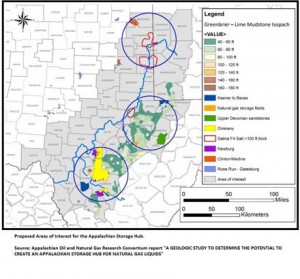From a Letter by Mary Wildfire, Charleston Gazette, February 2, 2019
Area newspapers are full of editorials and op-eds lauding the proposed petrochemical storage hub as the salvation of the Ohio Valley. Others discuss the downside: the risks of air and water pollution, the degradation of a quiet, rural landscape into an industrial zone, and the increase in drilling and fracking it would spur, with all the associated harms in the nearby gasfields of the Marcellus and Utica shales. Health threats are also mentioned, as is climate change.
But I see other risks nobody seems to be talking about. If proponents have their way, scores of billions of dollars will be sunk into this complex of storage caverns, crackers and plastic plants, plus the pipelines to connect all the components. What if the complex doesn’t operate long? We will be left with an enormous, ugly mess lining the Ohio River, and likely no money and other resources left either to clean it up or to build something more practical. I see two possible reasons why this might happen.
One is the possibility that the resource is not nearly as extensive as claimed. David Hughes, a Canadian geologist, produced a report a few years ago called “Drilling Deeper” in which he examined the data, well by well, for shale oil and gas in the U.S. He found that estimations by the U.S. Energy Information Administration are highly optimistic in essentially all cases; the word he used for the Marcellus was “extremely” optimistic.
The report notes that drillers here, in an effort to become profitable, are concentrating on “sweet spots” — when those are exhausted, they will have to turn to less promising sections.
Wait, to become profitable? Aren’t they profitable now? Not according to a series by DeSmog Blog, which suggests that most of the gas companies are struggling to pay creditors (one of the posts says they want to cut costs by automating, which executives say will improve worker safety — by eliminating workers). The hub is intended to make use of the natural gas liquids that are a byproduct of the “dry gas,” which is burned for heat or electricity generation.
The other threat to the long-term viability of the petro complex is that it will ultimately be blocked or shut down by environmental concerns — either local ones such as those mentioned above, or the global ones of climate change and plastic pollution. Key to the complex, after all, is the production of plastic.
Industry claims to see a huge increase in demand — but people all over the world are increasingly concerned about the intractable problem of plastic pollution in the oceans, where it lasts for centuries and harms wildlife. Crackers and plastic plants also increase the local cancer rate, particularly for their workers, as well as other health problems.
Meanwhile, renewable energy and batteries keep getting cheaper. So between the possibility of economics causing a decline of the natural gas liquids source, and people being unwilling to accept the “externalities,” an enormously expensive petrochemical complex could become a stranded asset.
So then we’d finally get serious about a rapid build out of renewable energy, right? Maybe not — because it might be too late. Some who advocate for the termination of any new fossil fuel projects and their replacement with renewable energy may not realize this, but the production of solar panels is very energy-intensive, and exacting. Windmills require huge amounts of steel and concrete. We should increase the speed of the transition, many-fold — but it will require fossil fuel energy to do it.
Some say solar and wind can’t power their own replacement; this is not true, they repay their energy cost many times over. But there aren’t enough windmills and solar arrays yet to power the building of additional wind and solar equipment.
We have to use fossil fuels for this. If we wait until we hear the sucking sound of fossil fuels running out, it will be too late. We will then be stuck with not only the effects of the climate change we’ve already baked into the system but no advanced energy sources for future generations.
Candles and horses were good enough for our ancestors but there were a lot fewer people then. I’d rather my grandchildren had access to LED lights, refrigerators and computers; and if they stay in West Virginia, I’d rather they be able to visit the Ohio River, and enjoy the view — even catch some fish.
Ideally, if we had responsible and visionary leadership, there would be plenty of jobs making alternatives to plastic, and creating clean energy from wind, water and sun. But it will take public pressure to bring this about.
-
Mary Wildfire, of Roane County, is a volunteer with Ohio Valley Environmental Coalition.

